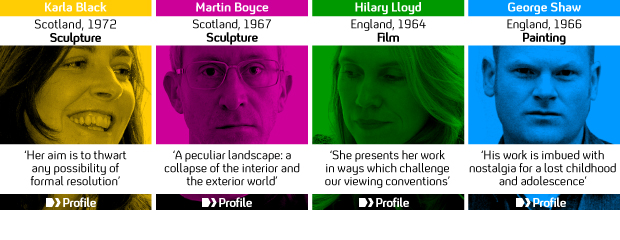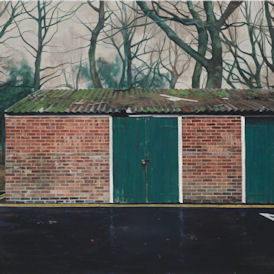Turner Prize 2011: nominations announced
A hanging sheet, an urban landscape, voyeuristic video and the dark undertones of a mundane childhood. Matthew Cain previews the Turner Prize shortlist.
- Chapters
- descriptions off, selected
- subtitles off, selected
- captions settings, opens captions settings dialog
- captions off, selected
This is a modal window.
This is a modal window. This modal can be closed by pressing the Escape key or activating the close button.
Sculptor Karla Black, painter George Shaw, film artist Hilary Lloyd and sculptor Martin Boyce have been shortlisted for the prestigious 2011 Turner Prize.
Karla Black mixes traditional art-making tools with materials such as mud and cosmetics to make sculptural instillations.
The natural fragility to some of the materials she uses echoes her fascination with psychological vulnerability. Black has talked about how heavily her work is rooted in feminism and its impact on the visual arts, primarily in its questioning of conventions of practice and interpretation.
More from Channel 4 on the Turner prize
She’s been nominated for her solo show at Galerie Capitain Petzel, Berlin, and for contributions to various group exhibitions. Read more about Karla Black here.
The second sculptor in the shortlist, Martin Boyce, creates installations inspired by concrete trees made for a 1925 modernist exhibition which are described as “evoking the urban landscape”.
The body of work which started out in Venice’s Palazzo Pisani was a series of atmospheric tableaux, which included rusty tables, fallen leaves, discarded benches and upturned dustbins.

One critic called it ‘a kind of faded dreamscape that resembles in turn a drained pool, an abandoned garden or park, and an empty aviary’. Many more commented on the sense of sorrow or melancholy it evoked.
Boyce has been nominated for his solo exhibition at Galerie Eva Presenhuber, Zurich, which itself built upon his No Reflections exhibition at the 2009 Venice Biennale. Read more about Martin Boyce here.
Hilary Lloyd is the only artist in this year’s Turner Prize who has been nominated for her work in sound and vision.
Lloyd works in film and presents her work to the viewer in a way which challenges and undermines viewing conventions. A work which at first appears to show a still life is later revealed to be in perpetual motion.
Her “slightly voyeuristic” work is typified by video screens and projectors showing scenes including construction sites and workshops.
Lloyd has been nominated for her solo show at Raven Row in London.
Read more about Hilary Lloyd here.
Painter George Shaw is the final 2011 Turner Prize nominee, who has been shortlisted for his work documenting scenes from the Coventry estate where he grew up.
His work is painted entirely with Humbrol enamel paint normally used by model plane makers and focuses on images of the mundane, the everyday and the overlooked in the Tile Hill council estate.

Shaw himself has said that he’s obsessed with time passing and his work is imbued with nostalgia for a lost childhood and adolescence. Although the title of the show for which he’s nominated (taken from a line in Hardy’s Tess of the D’Urbervilles in which the heroine imagines the day of her death) hints at much darker undertones.
The painter has been nominated for his retrospective The Sly and Unseen Day at BALTIC, Gateshead – the location for this year’s Turner Prize exhibition. Read more about George Shaw here.
Established in 1984, previous Turner Prize winners include major names in art such as Gilbert and George, Damien Hirst, Antony Gormley and Gillian Wearing. Last year’s winner was Susan Philipsz for a sound installation.
Open to artists under the age of 50, the Turner Prize is judged by an independent jury that changes annually.
The 2011 award will be presented live on Channel 4 News on 5 December. The winner will receive a £25,000 prize and the other shortlisted artists receive £5,000.
The Turner Prize heads to Gateshead
It's quite significant that the Turner Prize is travelling outside London for only the second time in its near-30 year history (the first time was when it went to Liverpool to coincide with the European City of Culture celebrations in 2007), writes Culture Editor Matthew Cain.
Because the prize wasn't originally set up to bring contemporary art to the masses; the original impetus was simply to create an award which celebrated the latest developments in contemporary art.
This remit later evolved to encompass acting as a catalyst for debate around developments in the visual arts...
Click here to read more on the Turner Prize in Gateshead by Matthew Cain